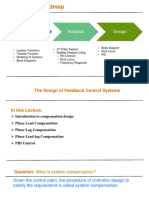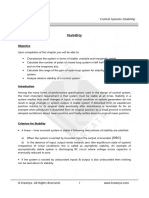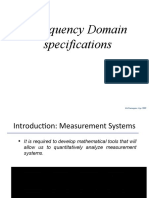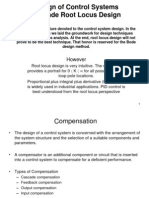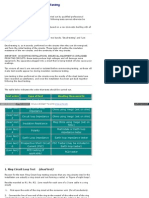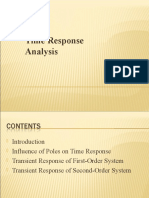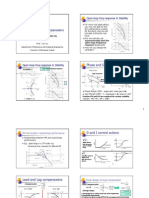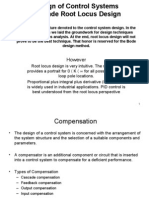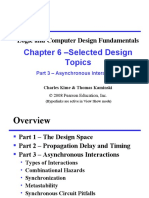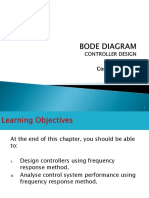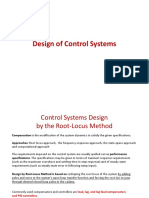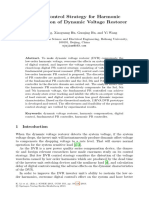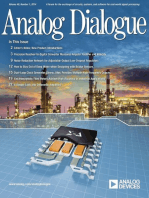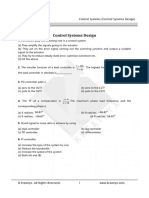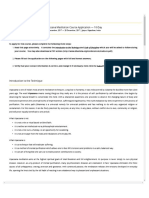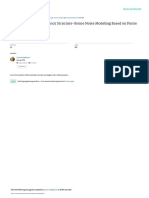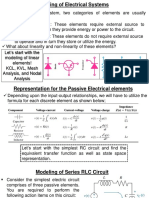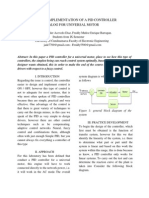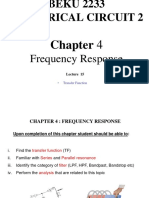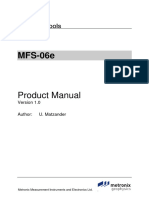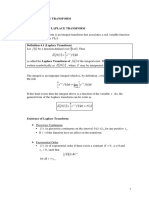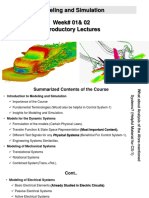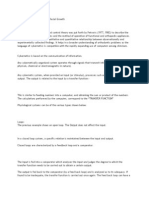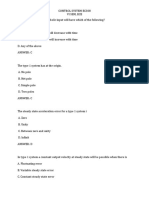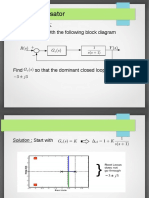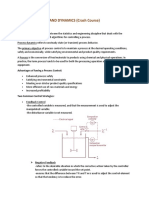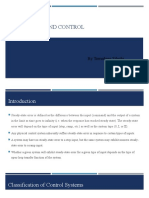CS Design 01
CS Design 01
Uploaded by
Prasun SinghalCopyright:
Available Formats
CS Design 01
CS Design 01
Uploaded by
Prasun SinghalCopyright
Available Formats
Share this document
Did you find this document useful?
Is this content inappropriate?
Copyright:
Available Formats
CS Design 01
CS Design 01
Uploaded by
Prasun SinghalCopyright:
Available Formats
Control Systems (Control Systems Design)
Control Systems Design
Objectives
Upon completion of this chapter you will be able to:
Design different compensators to meet the frequency domain specifications of any
Control System.
Design different controllers and understand their effects on time domain
specifications of any Control System.
Introduction
For any system, the specifications of output can be described in terms of time domain
parameters like t , t , t , t ,M & e and in frequency domain using parameters like
d r p s p ss
M , , Gain margin, phase margin, Bandwidth. To meet these specifications, process
r r
parameters are not altered but rather we add additional components that can modify these
characteristics to meet the specifications.
Controllers or compensators are additional components that will be added to existing design
to improve the time domain & frequency domain specifications respectively.
Compensators
Compensator is an electrical component which will be introduced in series with the forward
path transfer function in order to introduce certain phase angle into steady state sinusoidal
response of the system.
This property helps us change the phase of the Transfer Function and hence alter the Phase
margin of the system to impact Stability of the system.
© Kreatryx. All Rights Reserved. 1 www.kreatryx.com
Control Systems (Control Systems Design)
Lead Compensators
Lead Compensators introduce phase lead or positive phase shift into sinusoidal response of
the system.
Pole P
c
1
, Zero Z
c
1
a
Zero is closer to origin than pole, so a 1
The pole-zero plot of the Lead Compensator is shown
in the adjoining figure
1
sZs
c a
Transfer Function Gc s
s P
c
1
s
P
a c 1, 0
Z
c
G s 1 as 1
c a s 1
1 ja 1
G j
c a j 1
tan1 a tan1
Since, a 1 , so Ф is always positive and thus it provides lead angle.
Maximum phase angle
m
Frequency for maximum phase angle =
m
d
For maximum phase shift 0
d
© Kreatryx. All Rights Reserved. 2 www.kreatryx.com
Control Systems (Control Systems Design)
a
0
1 2a2 2 1 2 2
1 1
m
a2 a
a1 a 1
sin1 tan1
m a1 2 a
Bode Plot for this system is shown below:
The gain at high frequencies is higher as compared to low frequencies as observed from
Bode Plot so it acts as a High Pass Filter.
Electrical Network
E s
0
R
2
R
2
1
R Cs 1
E s R R R R R C
i 1 1 2 1 2
s 1
R sC R R
2 1 1 2
R
1 sC
R R
a 1 2 1 ; R C
R 1
2
© Kreatryx. All Rights Reserved. 3 www.kreatryx.com
Control Systems (Control Systems Design)
Effect of lead compensator
1. Improves the transient response, makes the system response faster.
2. Increases the margin of stability, that means improve the stability.
3. Increases the bandwidth.
4. The noise level in output increases, due to which SNR decreases S / N S / N
o i
5. It helps to increase the error constant up to some extent, but doesn’t affect steady state
error much.
Lag Compensator
Lag compensator introduces phase lag or negative phase shift into sinusoidal response of
the system.
Pole P
c
1
, Zero Z c a1
Pole is closer to origin than zero & hence a 1 .
The pole-zero plot of lag Compensator is shown
in the adjoining figure.
1
sZ s
c a
Transfer Function Gc s
s P
c
1
s
P
a c 1
Z
c
1 as 1
G s
c a s 1
1 ja 1
G j
c a j 1
© Kreatryx. All Rights Reserved. 4 www.kreatryx.com
Control Systems (Control Systems Design)
tan1 a tan1
Since, a 1, is always negative and thus it provides a lag angle.
Frequency for maximum phase shift is given by:
1
= GM of both corner frequencies.
m a
The maximum phase shift is given by the expression:
a1 a 1
sin1 tan1
m a1 2 a
The Bode Plot for this system is shown below:
The gain at lower frequencies is higher as compared to high frequencies as observed from
Bode Plot so it acts as a Low Pass Filter.
Electric Network
1
E s R R Cs 1
0 2 sC 2
E s
i R R
1 2 sC
1
1 2
R R Cs 1
R
a 2 1
R R
1 2
© Kreatryx. All Rights Reserved. 5 www.kreatryx.com
Control Systems (Control Systems Design)
Effect of lag compensator
1. Improves the steady state response, it increase error constant and decreases steady state
error.
2. Decrease bandwidth.
3. Reduces effect of noise which means it increases SNR.
4. Reduce stability margin so makes the system less stable.
5. Does not affect transient response.
Lag – Lead Compensator
It is a compensation of lag & lead compensator which provides lag compensation at lower
frequencies & lead compensation at higher frequencies.
The pole-zero plot for Lag-Lead Compensator is shown below:
The Transfer Function for this system can be written as:
1 1
s s
b2 a1
Gc s
s
1 1
s
2 1
a>1 and b<1
© Kreatryx. All Rights Reserved. 6 www.kreatryx.com
Control Systems (Control Systems Design)
The Bode Plot for this system is shown below:
The gain at edges is more than the gain at middle of band so it acts as Band Stop Filter.
Electric Network
Remember, Lag-Lead compensator cannot be realized using lag and lead compensators
connected in cascade.
If we interchange the location of poles and zeroes we can realize a Lead-Lag Compensator
which provides Phase Lead at lower frequencies and Phase Lag at higher frequencies.
© Kreatryx. All Rights Reserved. 7 www.kreatryx.com
Control Systems (Control Systems Design)
Summary of Compensators
Compensator Pole-Zero location Type of filter
Lead High Pass
Lag Low Pass
Lead-Lag Band Pass
Lag-Lead Band Reject
Solved Examples
s4
Problem: The TF of a compensator is .The maximum phase lead frequency and the
s 16
corresponding phase is?
1 0.25s
Solution: TF= 4 .
1 .0.0625s
1 as
Comparing with
1 s
We get 0.0625 and a=0.25 =>a=4
1 1
m 8
a 0.0625 4
m 8
s4 1 m
tan tan1 m ; m 36.870
s 16 4 16
© Kreatryx. All Rights Reserved. 8 www.kreatryx.com
Control Systems (Control Systems Design)
Problem: Consider the open loop transfer function of unity feedback system as
21s 97
G(s) . The maximum phase angle provided by this system is?
(s 33)
21s
1
97 97
Solution: G(s)
33 s
1
33
1 as
Comparing with standard transfer function k
1 s
1 21 21 33
We get, = and a =>a= 7.1443
33 97 97
a 1 i.e. Lead Compensator
a 1 1 7.1443 1
Maximum phase lead angle sin sin 48.97
1 0
a1 7.1443 1
Controllers
Controllers are the components that are connected in the forward path to change the steady
state response and transient response of the system.
There are different kind of controllers which have different impact on characteristics of the
system as described below:
© Kreatryx. All Rights Reserved. 9 www.kreatryx.com
Control Systems (Control Systems Design)
Proportional (P)
In proportional controller, the actuating controller signal is proportional to applied input
error signal.
y t e t
y t K e t
p
Y s
K
E s p
Without P controller With P controller
1 k
G s p
G s
s s 10 s s 10
2 2
Characteristic equation: s 10s 10 0 Characteristic equation: s 10s Kp 0
10
10 rad s and 10
n 2 K rad s and
n p K
p
Using proportional controller, the transient response can be improved but e
ss cannot be
altered.
Derivative (D)
In D controller the actuating signal is proportional to derivative of input error signal.
d
y t e t
dt
d
y t k e t
d dt
Y s
k ds
E s
© Kreatryx. All Rights Reserved. 10 www.kreatryx.com
Control Systems (Control Systems Design)
Without D Controller With D Controller
1 K ds kd
G s G s
s2 s 10 s2 s 10 s s 10
e = constant for parabolic i/p.
ss 2
Characteristic equation: s 10s k d 0
G(s) = unstable
For stability k 0 always
d
G (s) = stable and e for parabolic
ss
input
Using derivative controller stability can be improved but steady state response gets poorer.
Integral (I)
An integral controller gives an output proportional to the integral of input error signal.
y t e t dt
y t k e t dt
i
Y s K
i
E s s
Without I Controller With I Controller
1 K
i
G s G s
2
s s 10 s s 10
System is stable. Characteristic equation: = s3 10s2 K 0
i
e = constant for ramp i/p It is unstable
ss
e 0 for ramp input.
ss
© Kreatryx. All Rights Reserved. 11 www.kreatryx.com
Control Systems (Control Systems Design)
Using integral control, steady state response can be improved but stability is reduced.
PI Controller
In PI controller, the actuating output is proportional to input error signal and integral of
input error signal.
y t e t e t dt
y t K e t K e t dt
p i
Y s K
K i
E s p s
Without PI Controller With PI Controller
K
1
G s K i
s s 10 p s
G s
s s 10
System is stable
Characteristic Equation :
:
e = constant for ramp input s3 10s2 kps K 0
ss i
System is stable if 10k K 0
p i
e 0 for ramp input
ss
PI controller improves steady state response without affecting stability of the system.
PD Controller
In PD controller, the control action is proportional to error signal as well as its derivatives.
d
y t e t e t
dt
© Kreatryx. All Rights Reserved. 12 www.kreatryx.com
Control Systems (Control Systems Design)
d
y t K e t K
d dt
e t
p
Y s
K K s
E s p d
Without PD Controller With PD controller
1 K K s
G s p d
G s
s2 s 10
s2 s 10
It is unstable
3 2
Charact. Equation s 10s K ds Kp 0
e = constant for parabolic input
ss
Stable if 10k k 0
d p
e = constant for parabolic input
ss
PD controller improves stability without affecting steady state response of system.
PID Controller
In PID controller, all 3 control actions are incorporated so it can improve transient & steady
state response as well as stability of the system.
© Kreatryx. All Rights Reserved. 13 www.kreatryx.com
You might also like
- Experiment No: 6: D.C. Motor Position Control SystemDocument10 pagesExperiment No: 6: D.C. Motor Position Control SystemMayank ShahabadeeNo ratings yet
- Solutions To Homework 4: Problem 1 (15 Points)Document15 pagesSolutions To Homework 4: Problem 1 (15 Points)joa91189100% (1)
- Application of Math Principles To Engineering Problems 11th Edition 7-18-18 PDFDocument431 pagesApplication of Math Principles To Engineering Problems 11th Edition 7-18-18 PDFWanjiru randolphNo ratings yet
- Lecture 380-23-202 Design p1Document41 pagesLecture 380-23-202 Design p1yfm9bnzb2gNo ratings yet
- Control II - Part 8Document16 pagesControl II - Part 8mohamed rabieiNo ratings yet
- GEE338 LCS Chapter - 4 Design of CompensatorsDocument42 pagesGEE338 LCS Chapter - 4 Design of Compensatorsmarwanosama229No ratings yet
- Chapter 7 System Compensation: (Linear Control System Design)Document35 pagesChapter 7 System Compensation: (Linear Control System Design)Khin AyeNo ratings yet
- CHP 5Document69 pagesCHP 5million shiferawNo ratings yet
- Control Systems - Construction of Bode PlotsDocument3 pagesControl Systems - Construction of Bode Plotsjosphat mbathaNo ratings yet
- CS Time Response TDocument26 pagesCS Time Response TPrasun SinghalNo ratings yet
- Slide 1 - Slide 1Document52 pagesSlide 1 - Slide 1maketoNo ratings yet
- Notes On Control Systems 05Document11 pagesNotes On Control Systems 05Yazdan RastegarNo ratings yet
- Experiment 8Document6 pagesExperiment 8mehwishbano9998No ratings yet
- CS Stability Control TDocument15 pagesCS Stability Control TPrasun SinghalNo ratings yet
- Chapter 10 PID 1Document36 pagesChapter 10 PID 1Taufiq GalangNo ratings yet
- Frequency Domain Specifications: Ali Karimpour Apr 2009Document129 pagesFrequency Domain Specifications: Ali Karimpour Apr 2009shilpi lavaniaNo ratings yet
- The Design of Feedback Control SystemsDocument36 pagesThe Design of Feedback Control SystemsNirmal Kumar PandeyNo ratings yet
- ROOT LOCUS Control System DesignDocument25 pagesROOT LOCUS Control System DesignJustin Watkins100% (1)
- Feedback AmpDocument76 pagesFeedback AmpBayu AjiNo ratings yet
- Introduction To Control System DesignDocument63 pagesIntroduction To Control System DesignisbetaaccountNo ratings yet
- Chapter 8 (Lag Compensation)Document40 pagesChapter 8 (Lag Compensation)Nischal MaharjanNo ratings yet
- Frequecny Response of Lag NetworkDocument4 pagesFrequecny Response of Lag NetworkAnbalagan GuruNo ratings yet
- Claydons Org Public HTML Elec Testing HTMDocument7 pagesClaydons Org Public HTML Elec Testing HTMYan AungNo ratings yet
- Frequency ResponseDocument30 pagesFrequency ResponseGovind KumarNo ratings yet
- 1 Bode PlotDocument6 pages1 Bode PlotAdithya AdigaNo ratings yet
- Time Response AnalysisDocument57 pagesTime Response AnalysisAbdelnasirNo ratings yet
- EET302 M2-Ktunotes - inDocument33 pagesEET302 M2-Ktunotes - inAkhilaNo ratings yet
- Unit 5 1. Compensator Design Using Bode Plot: Points To RememberDocument10 pagesUnit 5 1. Compensator Design Using Bode Plot: Points To RememberRajasekhar AtlaNo ratings yet
- 351 - 27435 - EE411 - 2015 - 1 - 1 - 1 - 0 3 EE411 Lec6,7 Compensation RLDocument47 pages351 - 27435 - EE411 - 2015 - 1 - 1 - 1 - 0 3 EE411 Lec6,7 Compensation RLMohamed SaeedNo ratings yet
- Control Systems I: CompensationDocument47 pagesControl Systems I: Compensationi dint knowNo ratings yet
- LLC Resonant Converter 1713008423Document10 pagesLLC Resonant Converter 1713008423im.pavantomarNo ratings yet
- Bmt437-Time Response AnalysisDocument35 pagesBmt437-Time Response Analysisharshasri89No ratings yet
- Lecture - 6 - Lag - Compensation Design by The Time Response MethodDocument38 pagesLecture - 6 - Lag - Compensation Design by The Time Response MethodAliaa Tarek AliNo ratings yet
- Compensator BTechDocument25 pagesCompensator BTechAkash RoyNo ratings yet
- PCEE-612 Lecture-13Document50 pagesPCEE-612 Lecture-13mr.kunal118No ratings yet
- 14 Lead LagDocument3 pages14 Lead Lagrevs_eeeNo ratings yet
- Design FrequencyDocument5 pagesDesign FrequencyGustavo SánchezNo ratings yet
- Phase Lead and Lag CompensatorDocument8 pagesPhase Lead and Lag CompensatorNuradeen MagajiNo ratings yet
- Lecture 13 Signal Flow Graphs and Mason, S RuleDocument27 pagesLecture 13 Signal Flow Graphs and Mason, S RuleHamza KhanNo ratings yet
- Lec Notes v2.0 - Frequency Response & Bode PlotsDocument18 pagesLec Notes v2.0 - Frequency Response & Bode PlotsSamuel NyaangaNo ratings yet
- LCS R19 - Unit-4Document17 pagesLCS R19 - Unit-4ROG Nation YTNo ratings yet
- Lead Compesators Lecture NotesDocument10 pagesLead Compesators Lecture NotestechifiafricaNo ratings yet
- 351 - 27435 - EE419 - 2016 - 1 - 2 - 1 - 0 3 EE419 Lec6,7 Compensation RLDocument47 pages351 - 27435 - EE419 - 2016 - 1 - 2 - 1 - 0 3 EE419 Lec6,7 Compensation RLtsegayNo ratings yet
- CompensatorDocument69 pagesCompensatorKarthika KandasamyNo ratings yet
- Compensation Design Peak Current BuckDocument13 pagesCompensation Design Peak Current Bucksalageo97No ratings yet
- Sheet 5Document1 pageSheet 5bipico9217No ratings yet
- Lecture 18 Static Error Constants and System TypeDocument21 pagesLecture 18 Static Error Constants and System TypeHamza KhanNo ratings yet
- Aspen RazoaDocument11 pagesAspen RazoaGiovani ScarpatiNo ratings yet
- Daks Hee 324Document6 pagesDaks Hee 324kumawatpraveen144No ratings yet
- Design of Control Systems Cascade Root LocusDocument25 pagesDesign of Control Systems Cascade Root Locusaymanwolf3No ratings yet
- Chapter 6 - Selected Design Topics: Logic and Computer Design FundamentalsDocument23 pagesChapter 6 - Selected Design Topics: Logic and Computer Design FundamentalsMohammad AlsheyyabNo ratings yet
- Bode Diagram - Controller DesignDocument32 pagesBode Diagram - Controller DesigntiraNo ratings yet
- Lec Notes 7 Root Locus DesignDocument30 pagesLec Notes 7 Root Locus DesignFerhat TekoğluNo ratings yet
- Digital Control Strategy For Harmonic Compensation of Dynamic Voltage RestorerDocument9 pagesDigital Control Strategy For Harmonic Compensation of Dynamic Voltage Restorerwwahib2No ratings yet
- 7 - Frequency Response DesignDocument44 pages7 - Frequency Response DesignmisterNo ratings yet
- Elen665 PassiveRLC I Lect3Document49 pagesElen665 PassiveRLC I Lect3Habita KadourNo ratings yet
- Lag CompensationDocument40 pagesLag CompensationMeer Zafarullah NoohaniNo ratings yet
- BGR Design TechniquesDocument5 pagesBGR Design Techniquessachin saxenaNo ratings yet
- Phase Lead Compensator Design Using Bode Plots: ObjectivesDocument7 pagesPhase Lead Compensator Design Using Bode Plots: ObjectivesMuhammad AdeelNo ratings yet
- Digital Control Systems (DCS) : Lecture-1-2 Lead CompensationDocument61 pagesDigital Control Systems (DCS) : Lecture-1-2 Lead CompensationMeer Zafarullah NoohaniNo ratings yet
- Analog Dialogue, Volume 48, Number 1: Analog Dialogue, #13From EverandAnalog Dialogue, Volume 48, Number 1: Analog Dialogue, #13Rating: 4 out of 5 stars4/5 (1)
- Logic FamiliesDocument16 pagesLogic FamiliesPrasun SinghalNo ratings yet
- CS Design QDocument16 pagesCS Design QPrasun SinghalNo ratings yet
- CS State Variable TDocument21 pagesCS State Variable TPrasun SinghalNo ratings yet
- Locking Table Practice S5 Locking Table Practice Locking Table PracticeDocument34 pagesLocking Table Practice S5 Locking Table Practice Locking Table PracticePrasun Singhal100% (1)
- Air Circuit Breaker CataloguesDocument37 pagesAir Circuit Breaker CataloguesPrasun Singhal0% (1)
- VipassanaDocument6 pagesVipassanaPrasun SinghalNo ratings yet
- Virtual SEA Mid-Frequency Structure-Borne Noise Modeling Based On Finite Element AnalysisDocument11 pagesVirtual SEA Mid-Frequency Structure-Borne Noise Modeling Based On Finite Element AnalysisKivanc SengozNo ratings yet
- Introduction To Control Engineering-AdvDocument58 pagesIntroduction To Control Engineering-AdvkalebwondwossentNo ratings yet
- Week 5Document8 pagesWeek 5Yahya MateenNo ratings yet
- Closedloop PID Control of Universal MotorDocument9 pagesClosedloop PID Control of Universal MotorabhywaNo ratings yet
- Lab ManualDocument75 pagesLab ManualaathiraNo ratings yet
- Control Systems Lab ManualDocument55 pagesControl Systems Lab ManualNarendra ChaurasiaNo ratings yet
- Frequency Response Part1Document10 pagesFrequency Response Part1Mira BunsuNo ratings yet
- High Precision Position Control of Electro-Hydraulic Servo SystemDocument10 pagesHigh Precision Position Control of Electro-Hydraulic Servo Systemamin342No ratings yet
- MFS-06e: Product ManualDocument29 pagesMFS-06e: Product Manualgeo.yetaoNo ratings yet
- Process Dynamics and Control - Ch05Document20 pagesProcess Dynamics and Control - Ch05etayhailuNo ratings yet
- Chapter 4 Laplace TransformDocument17 pagesChapter 4 Laplace Transformain sharmilaNo ratings yet
- Modeling and SimulationDocument29 pagesModeling and SimulationMuhammad Hammad Javed IqbalNo ratings yet
- Cat 2 - CS - EeeDocument4 pagesCat 2 - CS - EeegallantprakashNo ratings yet
- EEB441-511 LE01-CH03 Modeling in The Time Domain 2023 PDFDocument50 pagesEEB441-511 LE01-CH03 Modeling in The Time Domain 2023 PDFLoniel LuxNo ratings yet
- Power Grid Synchronization by Controlling Frequency For Hydropower PlantsDocument47 pagesPower Grid Synchronization by Controlling Frequency For Hydropower PlantsTadele AmogneNo ratings yet
- Mathematical Modeling of Physical SystemsDocument44 pagesMathematical Modeling of Physical Systemsተሸመ ገረዝጊሄርNo ratings yet
- Cybernetic Theory of GrowthDocument12 pagesCybernetic Theory of GrowthRohan John Michael100% (4)
- Control System Toolbox in ScilabDocument17 pagesControl System Toolbox in ScilabAgus SukmanaNo ratings yet
- Average Current-Mode Control PDFDocument8 pagesAverage Current-Mode Control PDFQuickerManNo ratings yet
- 06cDocument69 pages06cDan FarrisNo ratings yet
- Control SystemDocument38 pagesControl SystemNishant SaxenaNo ratings yet
- 3130905Document2 pages3130905manish_iitr0% (1)
- Lead Compensator: Design ExampleDocument34 pagesLead Compensator: Design ExampleDharun SanthoshNo ratings yet
- Experiment 5 Transfer Functions: ObjectiveDocument4 pagesExperiment 5 Transfer Functions: Objectiveahmed shahNo ratings yet
- Lecture 8 - 9 - 10 - Time Domain AnalysisDocument132 pagesLecture 8 - 9 - 10 - Time Domain AnalysisSiraye AbirhamNo ratings yet
- Process Dynamics and ControlDocument32 pagesProcess Dynamics and ControlJohn Ray Clarin100% (1)
- Lecture 11 - Steady State ErrorDocument21 pagesLecture 11 - Steady State ErrorSiraye AbirhamNo ratings yet



